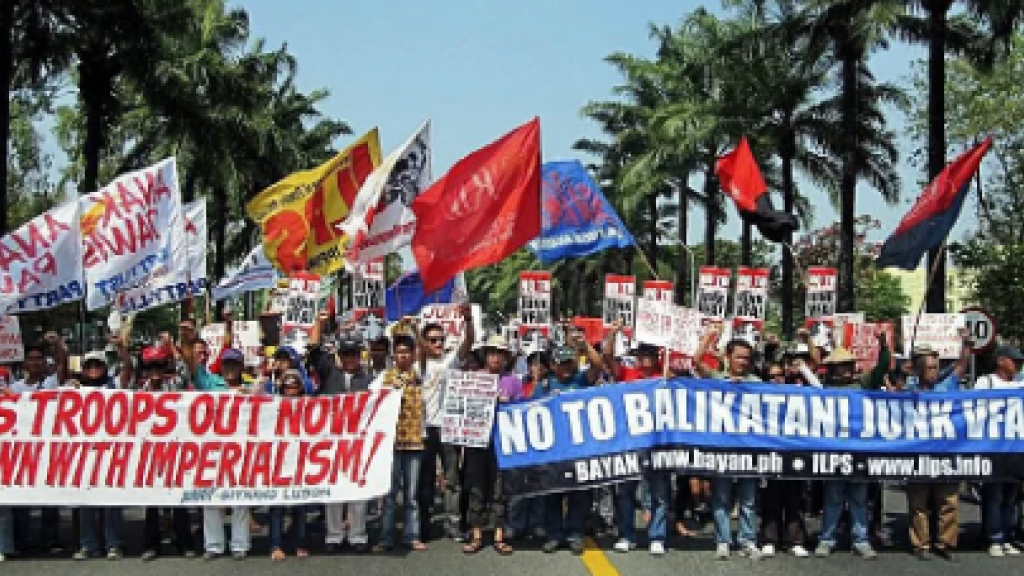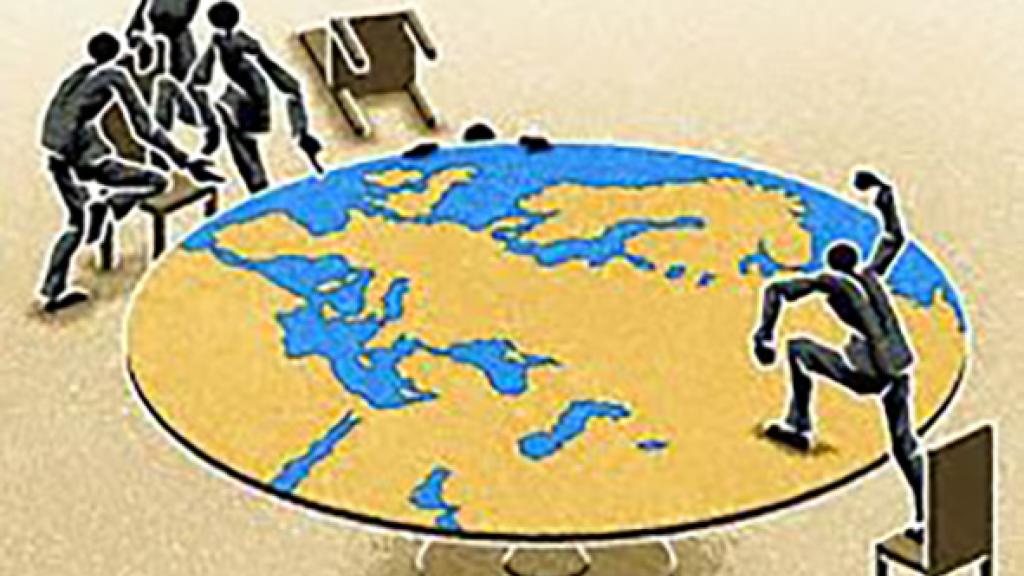The logic of imperialism’s ‘Maritime Great Game’ in the Southeast Asian Sea

First published at Amandla!.
The states with a coastline adjoining the Southeast Asian Sea are all facing a sharply rising regional quagmire. They are witnessing a soaring economic-diplomatic-security confrontation between the world’s top two imperialist powers. The United States of America and the People’s Republic of China are destabilising Southeast Asia by forcefully projecting their respective geostrategic objectives throughout the area. And by doing so, the region’s social majority — its working-class masses — are now becoming dangerously embroiled in this escalating great power collision.
A strategic competition
This imperialist rivalry is defined by the intensifying strategic competition between the US and China. They are both aiming to secure increased regional hegemony. So, they have unleashed parallel initiatives to thwart each other’s sweeping geopolitical designs for the immense Afro-Eurasia-Indo-Pacific as a whole — the Eastern Hemisphere.
In fact, these imperialist states are in relative decline. Only through international rivalry can they negate their weakened domestic conditions. Their reactions aim to protect their bourgeois socioeconomic formations from the fallouts of the chronically ruptured global capitalist system of production.
What is SEAS?
The Southeast Asian Sea is the vast expanse of salt water that lies within the southeastern region of Asia. Given its location, using the name ‘Southeast Asian Sea’, or ‘SEAS’, is more precise than the traditional name, the ‘South China Sea’. Another reason to use the name is to counter lingering inter-state frictions, which are encouraged by the use of nationalist-oriented place names for this marine realm. This readily breeds the reactionary phenomenon of national chauvinism and its destructive behaviours.
The Southeast Asian Sea remains one of planet Earth’s most diverse biospheres. It is a colossal aquatic ecosystem, covering approximately three and a half million square kilometres. It has over two hundred coral islets, an abundance of hydrocarbon deposits, and huge amounts of marine life. This organic wealth of natural resources is enough to sustain these states’ economies.
The Southeast Asian Sea is also a historically strategic marine domain that connects the Indian and Pacific oceans. As the region’s preeminent maritime corridor, its natural sea lanes provide crucial passage daily to enormous volumes of the world’s seaborne trade. It has key chokepoints in the straits of Malacca, Sunda and Lombok, and therefore acts as a vital channel for the trade between the economies of Europe, Africa and West Asia, and those of East Asia. And as a strategic sea spanning a zone of the Eastern Hemisphere, there is also a massive amount of shipping trade originating from the Western Hemisphere (i.e., North/Central/South America and the Caribbean).
Maritime Southeast Asia has consequently become a focus area for the competing interests of the world’s imperialist powers. Its regional security environment is now a turbulent arena of contestation for the major powers. They essentially seek to carve out additional space for capital accumulation through military means. This has turned the SEAS into an acute, perilous, global flashpoint.
A struggle between two imperialisms
The imperialist competition between the US and China is a particular manifestation of a generalised systemic crisis materially rooted in the inherent contradictions of the prevailing imperialist world system. Southeast Asia is being impacted by a strategic shift underpinning the bourgeois international order.
This great power engagement is unlike the last century’s Cold War. It is clearly not an international struggle between opposing ideological poles, supporting the strategic visions of contending socioeconomic systems. The first Cold War (1946-1991) was a clash of starkly counterposed systems — the capitalist camp (led by American imperialism) versus the communist camp (led by the former Soviet Union).
In contrast, the contemporary inter-imperialist conflict is being waged through a singular ‘capitalist unipolar order’. The contesting imperialist powers belong to the same capitalist pole. Together, they principally direct the monopoly capitalist agenda of the global core — albeit in an adversarial way.
Neither of them challenges the fundamentals of the capitalist system of production and distribution. Neither of them opposes globalised finance-monopoly capitalism’s exploitative norms of extracting surplus value through unequal exchange mechanisms to guarantee incessant capital accumulation for the imperialist core. Nor do they even attempt, in any serious way, to break imperialism’s circuits of global capital that oppressively control the periphery. Both American and Chinese imperialisms openly support the capitalist logic of guaranteeing the net flow of value (wealth) from the dominated countries to the centres of world capital.
Imperialist competition is mainly driven by the slow global pace of capitalist development due to stagnant growth with falling rates of profit. These negatives are made worse by other disruptive factors of the capitalist world economy, especially its generalised crisis of overproduction, along with overaccumulation, chronic underutilisation of capacity linked to constant mass unemployment, and global conditions of uneven and combined development. Thus, the central dynamics fueling this neo-Cold War moment stem from the contradictions intrinsic to the imperialist world system itself.
This system principally functions through the logic of super profits based on the eternal accumulation of capital. Its structure is built on exploitative and oppressive systems based on a global core-periphery model. In plain terms, this comprehensive socioeconomic formation supports and reinforces the capitalist, unipolar order.
The imperialist struggle for domination
Inside the global core lies a very small group of advanced capitalist economies. They are arranged into contending blocs led by the leading imperialist powers. These imperialist blocs directly compete with each other for economic control and political dominance over most of the world’s dependent semi-colonial states, which lie at the periphery. The power struggle between the US and China represents the current phase of the international system.
The imperialist blocs continually seek to increase the scope of their power through constantly expanding their respective spheres of influence and domination. In advancing their schemes for predominance, the imperialists try to reshape the international division of labour to favour their own geostrategic goals and interests. As a result, worldwide disputes, strife and wars inevitably erupt between them as they fight for global ascendancy.
These imperialist powers are always prepared to wage relentless acts of aggression beyond their frontiers. They do so to achieve a competitive advantage for their ruling classes. They engage in harmful and destructive economic competition, political schemes, and aggressive wars worldwide, regardless of the social cost. This is a general characteristic of monopoly capital. And during crisis moments, the imperialist states readily strike at each other in attempts to attain economic-political-security superiority for their own financial-oligarchic national regimes.
Unquestionably, the world suffers from the consequences of global polycrisis, which results from this in terms of the economy, politics, security, health, and climate emergency.
Following the ‘global capitalist crisis-depression’ that flared in September 2008, the US worked to regain and stabilise its international strategic position. It pursued this by strengthening its regional spheres of influence via attempts at reshaping the global economic and political order to align with its interests.
US strategy
US imperialism’s main goal remains the rejuvenation of American capital, chiefly through a revitalised global network of ever-expanding national markets in pivotal regions of the world. Combined with this, US imperialism robustly restimulates and weaponises monopoly capitalism for higher growth. It does so by producing enormous amounts of war materiel and using it in wars overseas. After the conflicts end, American capital then rebuilds the devastated countries. Through this coercive cycle, Washington aims to continually reshape the capitalist world order to maintain its global dominance.
In functional terms, American imperialism currently advances a redesigned, long-range, foreign-security policy framework. Driven by the Biden regime’s central mantra, “We are in a competition with China to win the 21st Century”, the US’s geostrategy is based on building strong regional economic and military alliances to counter China in the Asia-Indo-Pacific region. Guided by its dual 2022 geostrategic blueprints — the ‘National Security Strategy’ and the ‘Indo-Pacific Strategy’ — Washington’s main goal is to secure ‘free and open’ access to the region’s air and maritime arenas while limiting China’s opportunities for expansion.
By now, US imperialism has effectively extended the ambit of NATO into the Asia-Indo-Pacific. In also promoting market access initiatives, the ‘globalised NATO’ project aligns American monopoly capital’s economic and military priorities. To implement this strategy, Washington integrates the neoliberal Indo-Pacific Economic Framework for Prosperity (IPEF), along with alliances like the Australia-United Kingdom-United States (AUKUS), Quadrilateral Security Dialogue (Quad), and the Japan-Philippines-US political-military partnerships. Together, these coordinated efforts jointly form American imperialism’s battering ram to oppose Chinese imperialism in the region.
China’s strategy
To foil this, China has built up its own network. These include the Shanghai Cooperation Organisation (SCO), the Belt and Road Initiative (BRI), the Maritime Silk Road (MSR), the Conference on Interaction and Confidence-Building Measures in Asia (CICA), the Asian Infrastructure Investment Bank (AIIB), and the BRICS (Brazil/Russia/India/China/South Africa) grouping.
China’s comprehensive national power is not just a counterbalance to that of the US; it is also aimed at maintaining the global bourgeois system along imperialist lines.
Despite this, the US is succeeding in enticing other East Asian states to join its imperialist project to deny/degrade/damage the Chinese imperialist bloc’s regional strategic agenda. Integral to this, Washington regularly affirms its diplomatic narrative of “upholding the rules-based international order” (a code phrase for globally propping up US imperialist interests). So, it enlists blatantly pro-American states — like the Philippines — to openly provoke China. This is exemplified by the deployment of American troops and weaponry inside US-controlled military bases on Philippine territory.
The Philippines as a puppet in the struggle
Washington has a clear strategic plan, but Manila’s foreign policy planners fail to consider how China’s leadership thinks. Filipino leaders assume China will see their actions as harmless, even when the Philippines cooperates with the US. However, what really matters is how China (as a great power) views its external security environment — not what Manila claims. This allows Washington to strongly take advantage of Manila’s blind loyalty to the US to provoke China.
China’s social-chauvinist militarism in the Southeast Asian Sea should be condemned. Equally, the international communist movement must also denounce the joint US-Philippines military manoeuvres. Clearly, all imperialist wars of aggression must be opposed.
At present, US imperialism is already preparing for a possible limited war with China, using the Philippines as a trigger point to reshape Southeast Asia’s geopolitical landscape. Washington aims to strengthen its influence in the region to boost American economic growth and power. This will lead to a risky and significant shift in the ongoing imperialist competition within the area. And so, today, this is now Southeast Asia’s ‘Maritime Great Game’.
Rasti Delizo is a global affairs analyst. He is a member of the Bukluran ng Manggagawang Pilipino (BMP/Solidarity of Filipino Workers); BMP is a revolutionary socialist political centre of the Filipino working-class movement.

